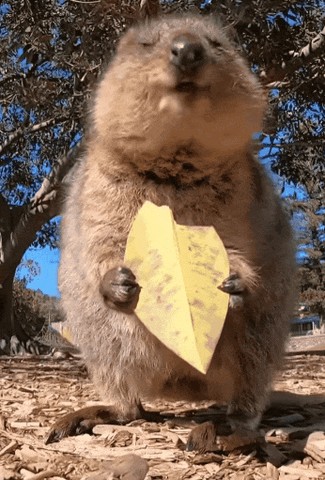Quokkas, often celebrated as “the world’s happiest animals,” are undeniably captivating creatures native to the southwestern regions of Australia. Their perpetually smiling faces and friendly demeanor have charmed people globally, leading to a common question: Can these adorable marsupials be kept as pets? As experts from pets.edu.vn, we delve into the reality of quokka ownership, separating fact from fiction and highlighting the importance of respecting wildlife.
Quokkas are small macropods, closely related to kangaroos and wallabies. They typically measure between 40 to 54 cm in head and body length, with a tail adding another 25 to 35 cm. Weighing between 2 and 5 kg, they possess sturdy hind legs, rounded ears, and a coat of brown to grayish-brown fur that is lighter on their underside.
Decoding the “Happiest Animal” Myth
The label “happiest animal” stems from the quokka’s facial structure and relaxed behavior. Their small, round faces with high-set eyes naturally create an impression of a smile. When relaxed, their facial muscles further enhance this upward curve, making them appear perpetually cheerful. This endearing “smile,” combined with their approachable nature, has solidified their reputation as joyful creatures, drawing tourists eager for a quokka selfie, particularly on Rottnest Island in Western Australia. However, it’s important to remember that this perceived happiness is an anthropomorphic interpretation of their physical characteristics and behavior, rather than a reflection of their emotional state in human terms.
Quokka Habitat and Natural Behaviors
Quokkas are primarily found in the southwestern corner of Western Australia, particularly on Rottnest Island and Bald Island, as well as isolated mainland populations. Rottnest Island, in particular, is renowned for its dense quokka population, thriving in the island’s varied vegetation which provides ample food and shelter. They favor habitats with dense undergrowth, grasslands, and near water sources.
These herbivores have a diet consisting mainly of grasses, leaves, bark, fruits, and occasionally young shoots. Quokkas are crepuscular animals, meaning they are most active during twilight hours, foraging in the early morning and dusk. During the day, they seek shade to rest and avoid heat. They create burrows or utilize rock crevices for nesting and shelter, sometimes building simple shelters from vegetation.
Quokka social structures are typically small family units or groups led by females. These units exhibit strong bonds, foraging and protecting young together. Adult males establish territories, defending them from rivals. Communication among quokkas involves postures, vocalizations, and scent signals, used for expressing emotions, warnings, and courtship. When threatened, they may display their teeth and posture defensively, and in extreme danger, they use their powerful hind legs to escape.
Quokkas can breed year-round, with females capable of producing one to two joeys annually. After a gestation period of about 25 days, a single joey is born and develops in the mother’s pouch for approximately six months, nourished by milk and protected until it can independently leave the pouch.
Debunking the Myth: Quokkas and Baby “Throwing”
A widely circulated, albeit inaccurate, claim suggests that quokka mothers “throw” their babies at predators as a defense mechanism. This sensationalized idea gained traction online, particularly after a popular animal trivia blog post in June 2018. However, the reality is more nuanced.
While quokka mothers do not intentionally throw their young, research indicates a survival strategy where, under extreme duress, a mother may loosen her pouch muscles, causing the joey to fall out. This is not an active throwing action, but rather a passive release. The fallen joey’s distress calls can distract a predator, providing the mother an opportunity to escape.
Scientific papers support this observation, noting the pouch loosening as a potential escape tactic. Furthermore, female quokkas possess a remarkable reproductive adaptation: embryonic diapause. They have two uteruses and can pause the development of a fertilized egg until the existing joey in the pouch matures or dies. This “spare baby” phenomenon might contribute to the understanding of this drastic survival strategy, as the mother’s reproductive future is not entirely jeopardized by the potential loss of a joey.
Conservation Status and Threats to Quokka Populations
Unfortunately, quokka populations face significant threats. Introduced predators like cats, foxes, and dogs have severely impacted their numbers. Habitat destruction due to urbanization, agriculture, and woodland clearing further reduces their natural range. The International Union for Conservation of Nature (IUCN) Red List classifies quokkas as “Vulnerable,” highlighting their precarious status.
Conservation efforts in Australia include establishing nature reserves and wildlife sanctuaries to protect quokka habitats, controlling introduced predators through monitoring and removal programs, and managing human activities in quokka areas. These measures are crucial to ensure the long-term survival of this unique species.
The Legality and Ethics of Quokka Ownership
Addressing the core question: Can Quokkas Be Pets? The answer is a definitive NO. Quokkas are protected under Australian law. Specifically, the Perth Rottnest Island Authority Act of 1987 explicitly prohibits keeping quokkas as pets. It is illegal to own a quokka in Australia, and this protection extends to international contexts as well, due to wildlife protection treaties and ethical considerations.
Beyond legal restrictions, keeping quokkas as pets is ethically problematic. They are wild animals with specific needs that cannot be adequately met in a domestic environment. Their specialized diet, social behaviors, and habitat requirements are ill-suited for typical pet ownership. Confining them to a domestic setting would cause undue stress and compromise their well-being.
If you admire quokkas and wish to have one in your life, consider a symbolic gesture by adopting a quokka through a wildlife conservation organization or supporting habitat preservation initiatives. For those desiring a quokka companion in a cuddly form, a plush toy offers a delightful and ethical alternative.
In conclusion, while the allure of owning a “happiest animal” is understandable, it is crucial to recognize that quokkas belong in their natural habitat. They are protected wild animals, and their well-being should be prioritized. Appreciate quokkas from a distance, support their conservation, and opt for a plush version if you desire a quokka companion in your home.
